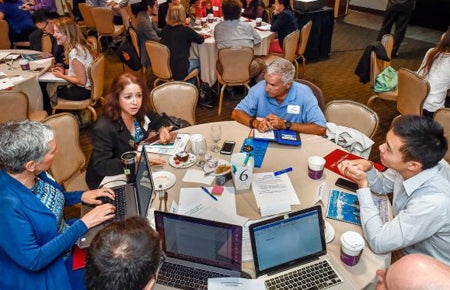
Students map out ways to make L.A. a friendlier place for the elderly
Which bus stops have benches? What is my emergency evacuation plan? Where are free flu shots offered?
Students in the new class “Age-Friendly L.A.,” a Wicked Problems Practicum sponsored by USC Provost Michael Quick, aim to provide answers to these questions and others in the hopes of making Los Angeles a better place to grow old. Using interactive maps, they’re developing a website and mobile app to tell layered stories about aging in Los Angeles that can serve as a resource for community leaders and residents.
“L.A.’s demographic diversity and geography make it a great training ground for tackling the most difficult issues related to aging in the built environment,” said Quick, who kicked off a daylong course workshop on the University Park Campus. “This course and event is just the beginning of our efforts to engage the community and participate in the discussion of how to make a more age-friendly Los Angeles.”
Los Angeles County is home to one of the world’s largest concentrations of older adults, a population that is expected to almost double, from approximately 1.1 million in 2010 to more than 2.1 million individuals by 2030.
Meaningful actions
City officials, students, professors, seniors and other stakeholders gathered for this first-of-its-kind charrette, a solution-design practice common in the field of architecture, to address housing, transportation, engagement and other measures that affect the quality of life for older adults.

Participants discuss issues that affect quality of living for older Los Angeles residents.
“We are going to be able to use all this information and the incredible interdisciplinary work here to be able to actually think of real, meaningful actions that will make differences in the lives of Angelenos going forward,” said Ashley Stracke, director of neighborhood services for Mayor Eric Garcetti.
The goal of the semester-long course is to gather students from USC Dornsife’s Spatial Sciences Institute, the USC Leonard Davis School of Gerontology, the Keck School of Medicine of USC and the USC Price School of Public Policy to examine life-span aging, health and social policy problems using graphic and visual representations that policymakers, professionals and researchers can understand and use.
“We can harness the power of maps and geography to tell the stories of the needs of older adults in Los Angeles,” explained Jennifer Swift, associate professor (teaching) of spatial sciences. Swift co-leads the course with Caroline Cicero, instructional assistant professor at the USC Leonard Davis School.
“We are training the next generation of leaders to think holistically about how cities can best meet the needs of their diverse aging populations,” Cicero said.
Life in the big city
Students aren’t just helping design a more livable city. They are providing directions for just how to get there. Currently few geographic visual representations, or geovisualizations of the requirements for elder-friendly communities, are available to community groups, researchers and stakeholders. The hope is that this class will change that. Students will present a website and app, featuring maps and stories of aging in Los Angeles, at a Town and Gown event on Jan. 31.
Participating faculty also include Darren Ruddell of spatial sciences, Annie Nguyen from the Keck School of Medicine, Tridib Banerjee from USC Price and Jennifer Ailshire from the USC Leonard Davis School.
The course is part of two efforts underway to help prepare for a rapidly aging society: Quick’s university-wide Wicked Problems initiative “Ensuring Lifespan Health,” led by USC Leonard Davis School Dean Pinchas Cohen, and Garcetti’s Purposeful Aging Los Angeles, a multi-agency drive in which USC Leonard Davis School is a partner to make Los Angeles the most age-friendly region in the world.